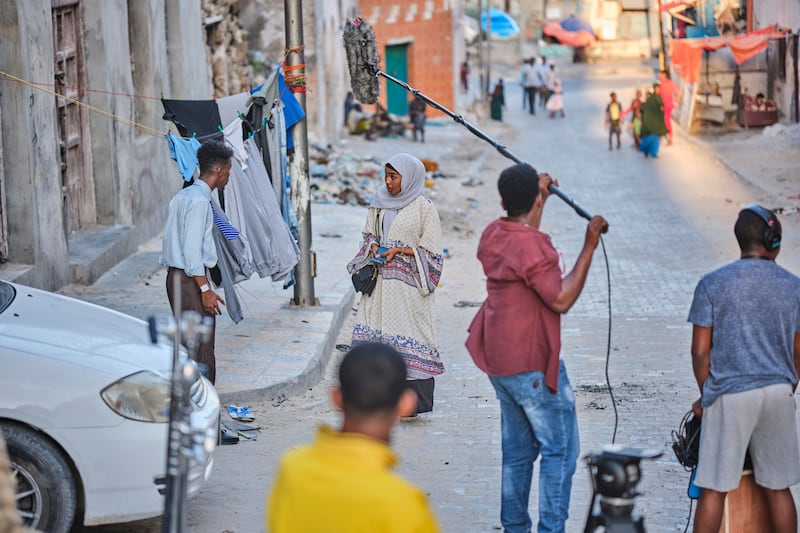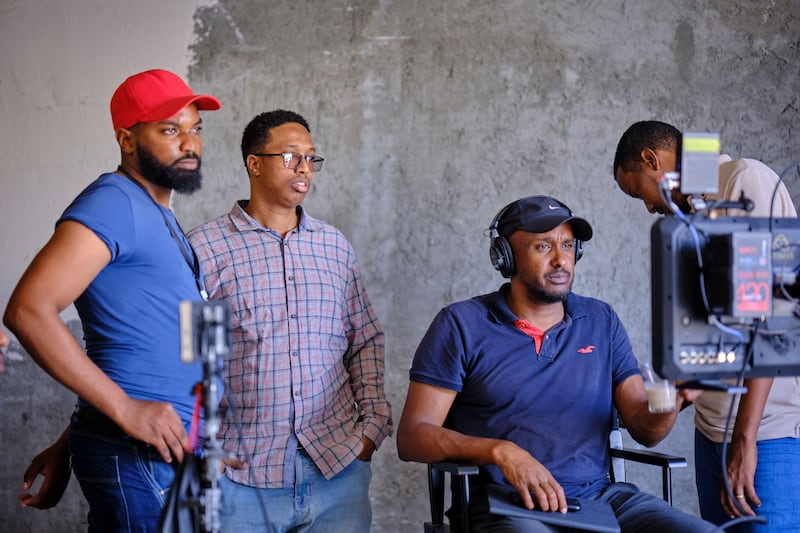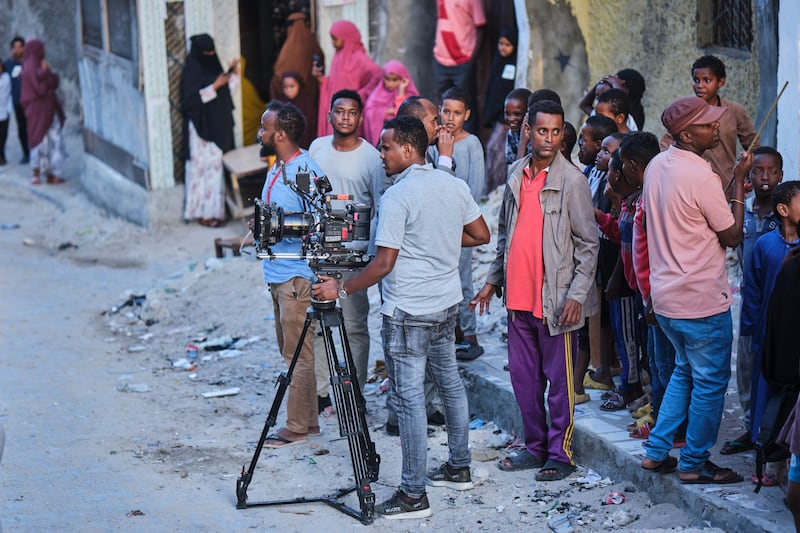Hibaaq, a young TikToker with a pink hijab and a leopard-print phone case, is cutting into a cake at a party she is holding to celebrate reaching one million followers. Her friends record her on their phones as she thanks them for their support. Then, there is an explosion.
These are the opening scenes of Arday, which translates as “student”: a new Somali 10-part TV show focused on the lives of teenagers in the Horn of Africa country. It is the first major TV series to be filmed on capital Mogadishu’s streets, and it’s got Somalis talking, stoking debate inside the country as well as among Somali diaspora across the world. Storylines include drug use, the traumatic effects of suicide bombings, and the sexual abuse and blackmail of young women. The cast is overwhelmingly untrained and many have personal experiences of issues similar to what their characters go through.
New episodes are screening on local station Bile TV before they go online on YouTube. The first episode, up since April 27th, has topped 1.9 million views online. English speakers can watch it with subtitles.
The comments underneath are overwhelmingly positive. “As a Somali from the diaspora, I have to say this is such an amazing and insightful series. I’m glad to see Somalis making and shaping the narratives for Somalis,” said one person, who gave their name as Hana B.
READ MORE
“This is my first time watching a Somali drama with my mother and family. We have come a long way when we see our stories being told without being villainised and slandered,” said another, who gave their name as Laaz Mohaz.
“It was absolutely fascinating! The way the film captured the nuances of daily life in Somalia was so creative and authentic. I loved how stunning visuals really brought everything to life,” wrote a third, who gave his name as Abdiaziz Bashir.

Speaking on the phone from Nairobi, Arday director Ahmed Farah says he has been pleased with the reaction so far. Young people and the diaspora, in particular, are excited, he says. “They are getting to see a different image from Somalia, [a] high school TV series.”
In contrast, religious leaders and a union representing educators have said publicly that they wanted to ban the show, claiming “it is distracting youth and also the topics we’re talking about [are] not good”.
Farah (44) grew up in the Netherlands. He moved to Somalia in 2011 and has been working across Africa since.
Girls jokingly refer to Mogadishu’s explosions and bombings as the ‘popcorn’
This month his first feature film, Ayaanle, premiered on Netflix in Africa, making it the first Somali film to go on to the international streaming platform, he says. It tells the story of a 21-year-old growing up in Kenya, who wants to become a Hollywood actor but instead gets accidentally involved with a terrorist group while scamming a news crew. Farah says it was inspired by his discovery that there have been actors featured as Somali pirates by international media in the past.
Roughly 75 per cent of Somalia’s population of about 17 million are thought to be under the age of 30, says Farah. But “there is no attention on them”, he says. “Their stories are untold.”
Somali TV broadcasts a lot of Indian and Turkish TV series, Farah says: “There is no real local content.” He praises Bile TV for recognising the benefit of funding the series.
[ Somalia’s fight against Al Shabaab, the group who must not be namedOpens in new window ]
Young Somalis have taken leadership and made sure the episodes are being watched, he says. On TikTok they post reactions to Arday, using its name as a hashtag and reaching “millions” more. “Youth is youth wherever they are in the world. And also with TikTok, social media ... even though you live in Somalia ... you get to see the rest of the world. They’re all connected with the youth outside Somalia,” says Farah.
The series depicts everyday life for young people in Mogadishu, from the sad, to sweet and funny, to disturbing. Viewers see students having their bags and bodies searched for weapons before they enter classes. Some students arrive in local bajajs, or tuk-tuks. Boys vie for attention from girls and in literature class students argue about whether rap is considered poetry. A mother and daughter sing to each other as the daughter does the mother’s make-up. Earlier, the same girl announced she planned to become vegan after berating her mother for making eggs with “unhealthy” sunflower oil. In her free time she helps her mother run a discussion programme on YouTube.
Girls jokingly refer to Mogadishu’s explosions and bombings as the “popcorn”. They use the term “juice kids” to speak about students who were born abroad, in countries such as Saudi Arabia or Yemen, where they don’t regularly drink camel milk. After one girl, Hiba, discloses that her father has arranged a marriage for her, another asks if it is with a “sugar daddy”.
Boys make bets with each other. One is accidentally shot and killed as his friends film a prank video for TikTok.

A lot of the filming happened inside the set of a school specially constructed. When they filmed outside crowd control was a problem, Farah says. “The community, they are not used to it ... [also] the traffic, the city is very loud.” He says there were occasional scares. “There are gunshots all the time ... You never know what’s going to happen ... Security challenges are always there in Somalia.”
Violence is a thread running through the show because it is a daily reality in Somalia. Though it is never named, al Shabab, the insurgent Islamic militant group linked to al-Qaeda, still carries out regular attacks in Mogadishu, killing more than 580 people in a 2017 bombing at a busy intersection, and at least 120 people near the same location last October. Government forces, aligned with clan militias, are involved in an offensive against the group.
Despite the turmoil, Arday season two is planned, though filming might be a more difficult now, Farah says, because of the fame they have achieved. “This is something that really can continue for many years ... You can educate the youth of Somalia and also the parents can learn from [it].”
The series is also “futuristic”, Farah says, showing how good Somalia’s education system could be if it was properly invested in. “Normally schools are overcrowded, the system is not that great,” he says. In Arday there are few students to a teacher and each has the chance for individual attention.
I know girls who are struggling to live, who are suicidal … I wanted to give them a platform, I wanted to tell their story but in a decent way … Youth will learn from it
The difference between the series and reality is most obvious with the inclusion of a school psychologist. The first episode features a teacher talking about the psychological problems that may affect survivors of suicide bombings; he says that a psychologist is available to speak to anyone who wants and that information they share will remain confidential.
“It’s normal, explosions happen all the time,” one student, Farah, a young man whose love interest was killed, later tells the psychologist, Doctor Sainab. “It’s not something new to us. But it’s something that we can’t forget. It’s something that affects us and hovers above us all the time.” He explains that his aunt also died in an explosion, while another friend was shot dead two years before. “From that day on, I felt lonely. You can understand, I was someone who lost everything ... I have suffered immensely, but I try to stay strong. I pretend to be okay and want to forget but I can’t,” he says. The psychologist gives him her number and says he can call her any time.
This focus on mental health is not present in Somali schools, Farah says. “It does not exist. Zero. There’s no help for mental health.” A joint study by the UN and Somalia’s health ministry, released this year, found about three quarters of Somalis might suffer from mental health problems.
Another Arday storyline may be considered more taboo. The drugging, naked photographing or raping of Somali women and girls on camera, often for blackmailing purposes, has become common in recent years, reports have found, including a recent Channel 4 News investigation. Farah – who once worked as a news cameraman – says he felt it was important to include this theme in the series.
“We also interviewed girls who went through this thing,” he says. He wanted to show how it affects the person who has been photographed and blackmailed. “It was very, very, very important, because lives have been destroyed. I know girls who are struggling to live, who are suicidal ... I wanted to give them a platform, I wanted to tell their story but in a decent way ... Youth will learn from it.” He wanted to teach young people “not to share [the videos and photos that are taken without consent], not to watch it, not to be part of it.”

Arday features about 40 actors, none of whom had worked in front of a camera apart from making their own TikTok videos, Farah says. “We held an audition and we had almost 200 applicants.” He says he picked young people who had similar experiences to their own characters, which “makes it easy for them to act themselves”.
He carried out research by watching other series about young people from different parts of the world – those he admires include the American teen drama series 13 Reasons Why. When it came to getting inspiration, however, he realised “the Somali situation is completely different ... In 30 years, no stories came out. So we are overwhelmed with stories”.
“Our country has been through a lot in the last 30 years with extremists and the warlords and the famine ... You can imagine yourself, that is why people are so excited and they feel there’s some kind of sort of normalcy coming back, where artists like me are now daring to shoot TV series.” Arday tackles taboos and may educate viewers, but it’s also entertainment, he says.
Farah says he wasn’t worried about whether the series makes Somalia look like a good or bad place overall, but he was conscious of the need to operate within “the lines” of Somali culture. “The reason we have so many views is that we’ve obeyed within the lines ... Our culture is very important [to get] support in the country.” He says the school uniforms, for example, are stylish and fashionable but the girls are not showing skin and have their heads covered.
Despite all the challenges, Farah says he is hopeful that the series will keep prompting conversations and garnering support. “In countries like Ireland, you learn cinema, you learn art,” he says, suggesting that fictional dramas hold a mirror up to society. In Somalia “this is new and people are scared of everything that’s new. And we hope, gradually, people understand this”.





















